The front room, parlor, or sitting room was the space used for entertaining guests. This room was often decorated in the latest fashion with the intention of impressing visitors. Some of the recovered artifacts represent objects, both functional and ornamental, that might have been used or displayed in the parlor at 1018 Palmer.
Marble Glass Spill Vase/Match Holder
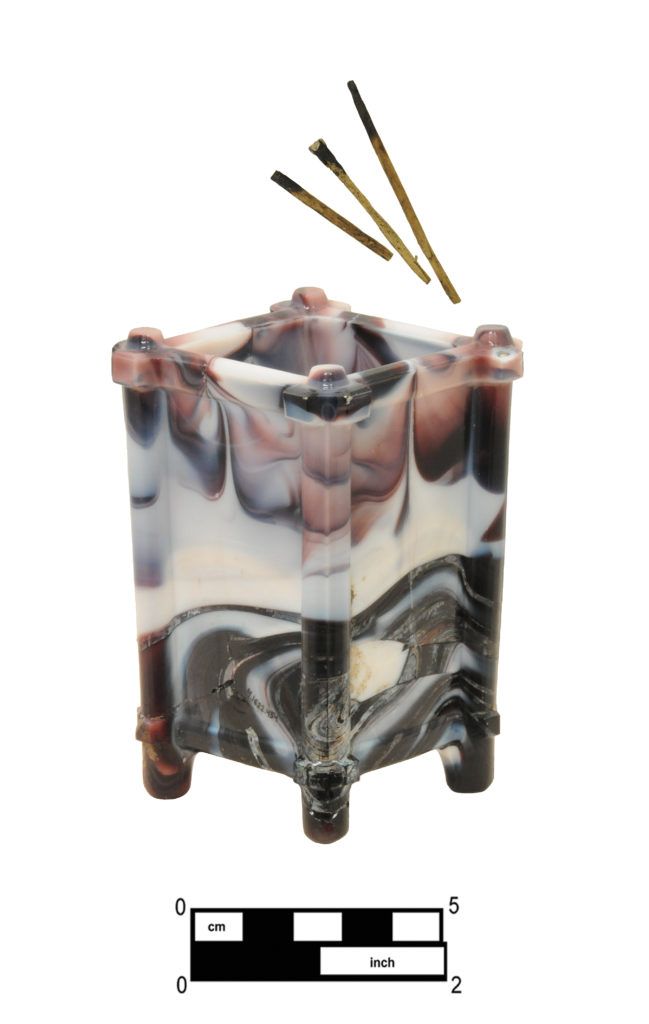
Small decorative containers like this one were often displayed on the fireplace mantle, where they were used to hold spills or matchsticks (4A-G-0141). Spills were slivers of wood or thin twisted strips of paper used to transfer a flame from the fireplace to light a lamp, pipe, or cigar. In their book, The American Woman’s Home, published in 1869, Catherine Beecher and Harriet Beecher Stowe advised “lamps should be lighted with a strip of folded or rolled paper, of which a quantity should be kept on the mantelpiece.” 1
This purple and white spill or match holder was made by carefully blending the two colors and pressing the marbled glass in a mold. Glass vessels formed in this manner were advertised by various names, including malachite, variegated, and marbled. While some objects are marked with symbols or letters identifying the glass factory where the piece was made, the recovered example is unmarked.
Malachite glass was developed at the Sowerby glassworks in England in 1878. 2 A Sowerby’s glass catalog dated 1882–1883 offered an identical form as “Pattern 1223” on a page featuring “Vases, Spills, Baskets &c.” 3 Similar variegated glass was produced by Challinor, Taylor and Company of Tarentum, Pennsylvania. 4 David Challinor of Pittsburg obtained U.S. Patent # 342,898, dated June 1, 1886, for the “Manufacture of Variegated Glassware.” 5 According to a description Lowell Innes provided, the Tarentum company may have manufactured pieces in a similar shape: “The writer can remember a small, square Mosaic vase with a rounded pillar at each corner that always rested on the marble washstand in his Grandfather Sawyer’s bathroom in Bibbeford, Maine. It held toothbrushes.” 6 This reminiscence is interesting, as it points to an alternative use for this vessel as a toothbrush holder.
Matchsticks
Several carved wooden sticks, each charred at one end, appear to be the remains of matchsticks (Cat # 4.25.938).
Mirror Glass
Some of the recovered mirror fragments vary in thickness, providing evidence that they originated from several different looking glasses. Historically, the mirror was an expensive piece of furniture that was not within everyone’s means. 7 Beyond a functional use, mirrors were a reflection of the economic status of their owners. Mirrors were often hung in the parlor, dining room, or entrance hall to display the wealth of the household to visitors. They were sometimes positioned near gas lamps or wall sconces to reflect and enhance lighting. Carefully placed mirrors might be used to make a room appear larger. “They add greatly to the handsome appearance of a parlor; and two placed opposite, will convert an insignificant room into quite a spacious apartment, apparently.” 8 By the end of the nineteenth century, mirrors of different sizes and in ornamental shapes were incorporated into all types of wooden furniture, such as cabinets, bookcases, and hall racks.9
Flower Vases
Vases were among the less expensive items of décor the Stocktons suggested in 1873, in their volume entitled The Home: Where It Should Be and What to Put In It. “There are other things besides pictures for adorning walls and giving beauty to a room. Two or three brackets with a little statuette, or vase of artistic design, or flower vase on them.” 10 Portions of two vases were identified among the variety of glass vessels recovered from this shaft feature.
Vase with Enameled Decoration
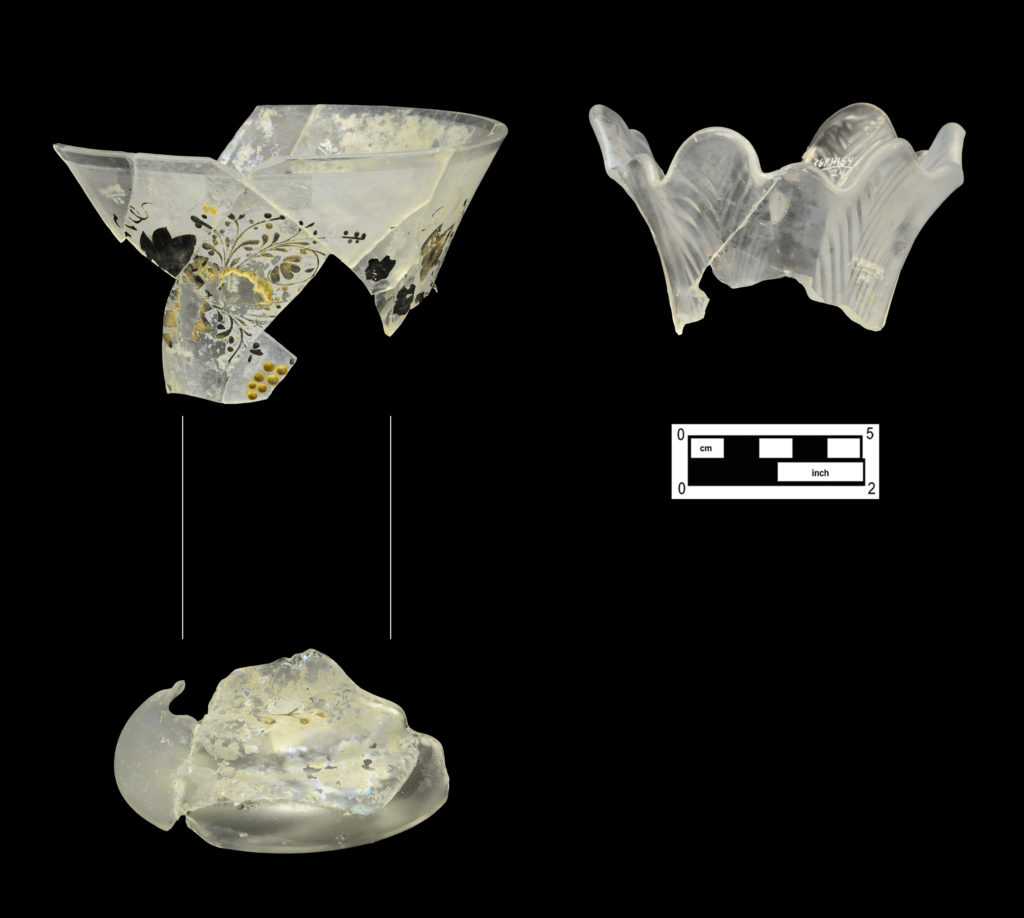
Portions of a colorless glass vase were recovered in a style similar to those advertised as “Bohemian glass” in late-nineteenth-century catalogs (4A-G-0378). 11 Most of the exterior has a matte appearance created by treating the surface with acid or by sand blasting. This example seems to match the description Montgomery Ward & Co. advertised in 1895: “#55544 Flower vase, etched or dull Bohemian glass, new and handsome pattern hand decorated with leaves and flowers in colors and gold…” 12 The recovered vase fragments still display portions of raised enameled design in black and gold. The motif appears to represent a grape vine with leaves in black and clusters of grapes in gold.
Carnival Glass Vase
The rim section from another glass vase exhibits an irregular scalloped edge (4A-G-0320). The glass appears colorless, except for some clouded areas; this is an example of white carnival glass. 13 The design is known as “Feather” and features alternating columns, with one left plain and the other bearing a repeating “V” design running lengthwise. The basic shape and design of this vase were formed by pressing the glass in a mold. The rim was heated again and crimped, possibly using a device similar to the one John Northwood patented on September 29, 1885 (Patent # 327,406). 14 The whole vase was: “reheated in the furnace and ‘swung’ on the end of a long rod—the centrifugal force pulling the glass into the elongated shape…” 15 The combined techniques gave the surviving rim of this vase an irregular scalloped appearance.
H. Northwood and Company of Wheeling, West Virginia, manufactured the Feather pattern. Although the base of this vase was not recovered, some examples have the Northwood mark: “N.” “Feather is one of the oldest vase designs, introduced in opalescent in 1904… This vase pattern remained in production through 1912 when the pastel colors were introduced.” 16 The date range suggests that the vase was displayed in the Bumm household or by one of the later occupants.
Bric-a-Brac
Several additional artifacts seem to fit into the category of “bric-a-brac”—a term used during the nineteenth century to describe “small articles collected for their antiquarian, sentimental, decorative or other interest.” 17
Figurines
Figurines were popular accent pieces often displayed on a mantle or shelf in the parlor. In the eighteenth and nineteenth centuries, many English potteries and German porcelain factories made figurines along with their regular production of ceramic vessels for the table. Some of the popular figural themes were historical figures, animals, and children. Babies and young children were among the popular subject matter and these figurines were frequently available in sets of two, typically featuring a boy and a girl.
Serenading Moon Man
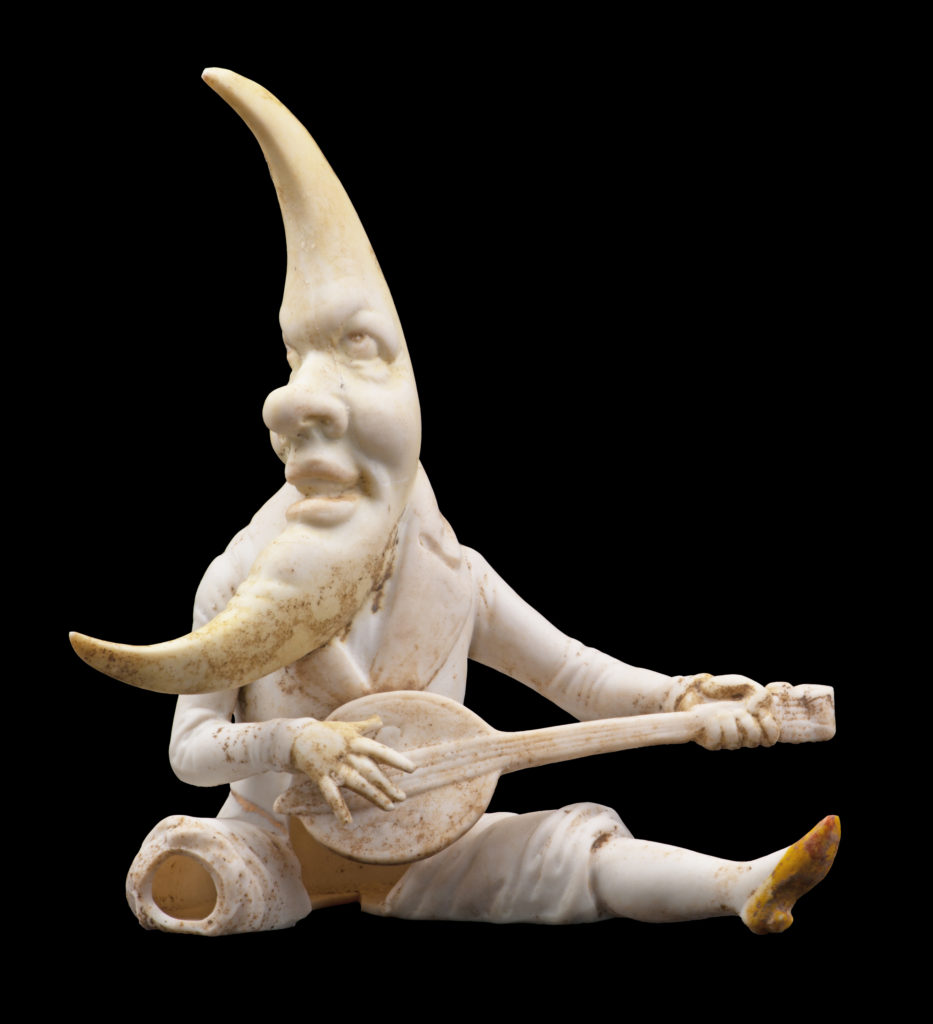
This small moon man figurine was molded from porcelain (Cat # 4.24.121). He was originally decorated with vibrant colors that faded over time, as the piece was not glazed during manufacture. Unglazed ceramic figures like this one are referred to as “bisque” porcelain. Some hints of the original coloring are evident on his head, hands, and surviving left slipper. The crescent moon’s head and hands were yellow in contrast with red lips. The mandolin was light brown, and two buttons on the back of his coat and his slippers were colored reddish orange.
This figure does not have a model number or other identifying marks that are sometimes found on the back or base of ceramic figurines. Initial research revealed no comparable examples using Internet resources; however, renewed efforts indicate that this figurine was part of a group of sun and moon figures produced by the Schafer and Vater Porcelain Factory. In 1890, Gustav Schafer and Gunther Vater established a pottery for the manufacture of porcelain in Rudolstadt, Thuringia, Germany. 18 The factory was known for producing a wide range of novelty ceramic items. Collector research states that by 1910, Sears, Roebuck and Company was importing and selling porcelain produced at the Schafer and Vater factory. 19 This would place the figurine in the household of the Bumm family or later occupants of the property. For more info about moon man see River Chronicles 2016.
Toddler Figurines
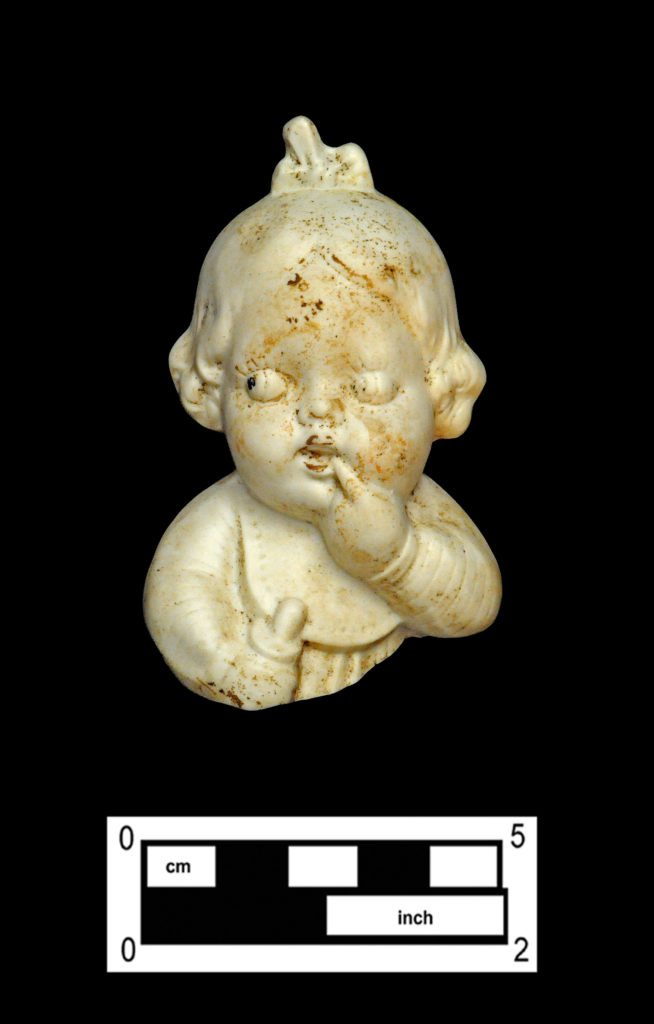
Pieces from two bisque porcelain figurines were recovered, each depicting the same round-faced child wearing a bib and clutching a teething ring (Cat # 4.24.118). This wide-eyed baby girl has a finger in her mouth and probably represents a teething toddler; the figure has a cartoon quality reminiscent of Kewpie dolls or the Campbell’s Soup kids. None of the fragments display a maker’s mark, although a few pieces were impressed with the model number “2674” and the country of manufacture, “Germany.” While the manufacturer remains unknown, the impressed country of origin suggests that they were made in the late nineteenth century. “The McKinley Tariff Act of 1891 required that the name of the country where the ceramic was originally made must be printed on each piece.” 20 These figurines may have been displayed by members of the Bumm or Nickles families while living at 1018 Palmer Street. Internet research conducted on the model number revealed a boy figurine with the same round face and big eyes, suggesting that these two figures were part of a set. No evidence of boy figurines was found among the artifacts excavated from this feature.
Ornamental Dishes
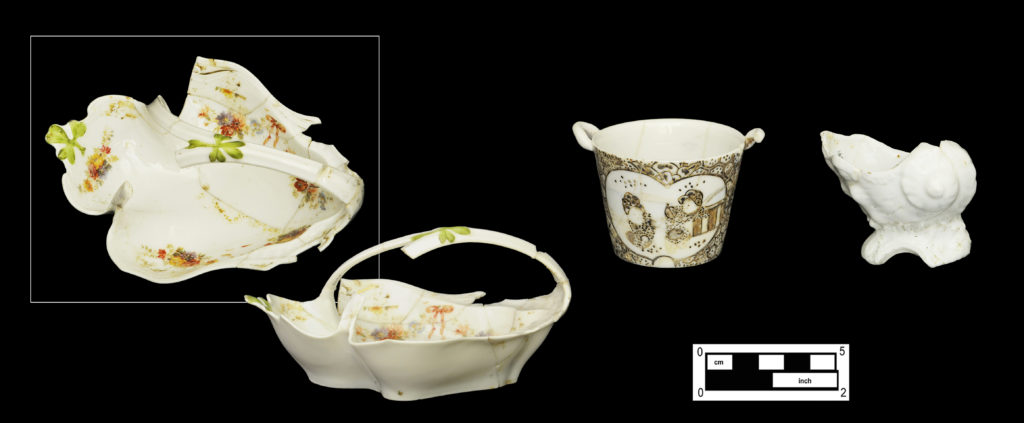
Three porcelain dishes, each of an unusual shape, may have decorated a shelf or table top. Small vessels like these might have functioned as holders for matches or toothpicks. The leaf-shaped porcelain dish features a painted clover motif and floral decals on the inside surface (4A-C-0033). There is no evidence of a maker’s mark, but the style of decoration suggests that this is a piece of European porcelain. The Japanese porcelain container features an enameled decoration that appears to show children at play (4A-C-0027). The small, horizontal loop handles at the rim seem to be decorative rather than functional. To date, research into this vessel has not yielded any additional information on the form, although the slightly flared bucket shape suggests it might have served as a container for toothpicks. Another small porcelain container was molded into the shape of a snail shell (4A-C-0032). This vessel features a faded gilt band around the rim and has remnants of green overglaze paint around the lower body. The base of this porcelain shell dish is marked with the number “155,” scratched into the clay when the piece was made and probably representing a model number.
Ambrotype
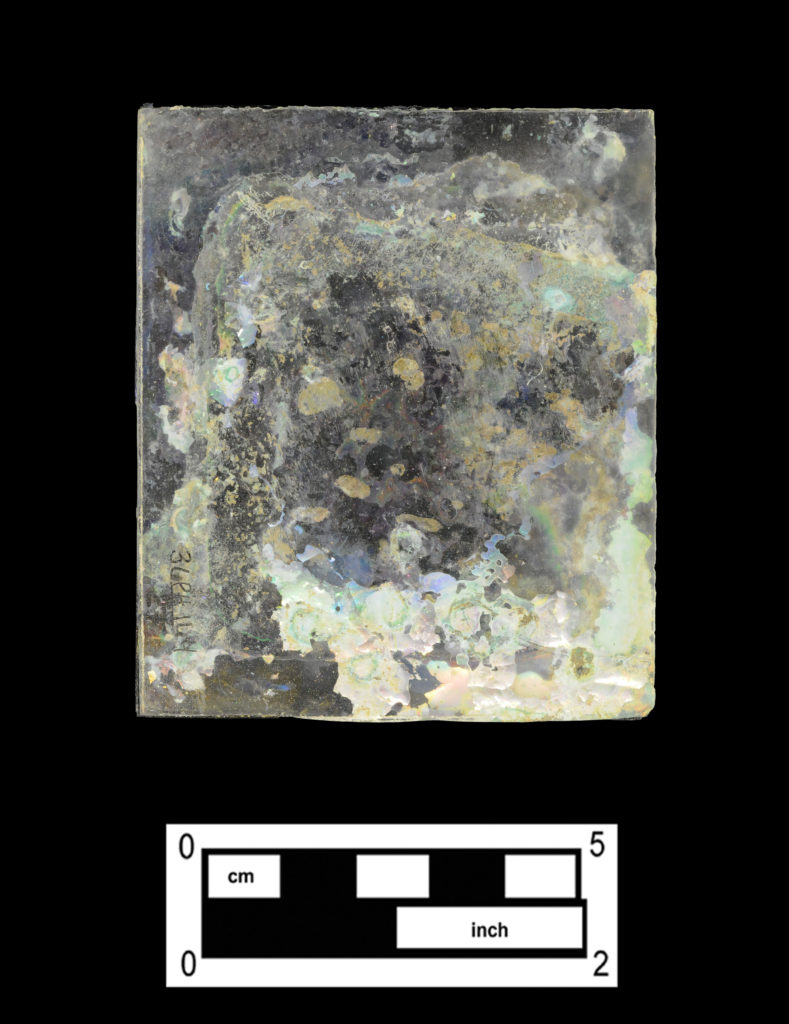
Two flat pieces of glass measuring 2.75 x 3 inches were initially thought to be a purse-sized cosmetic mirror. Ongoing research revealed that they are the glass plates from an early type of photograph called an ambrotype (Cat# 4.27.140). This photographic technique was available in Philadelphia in 1854, as noted in a newspaper advertisement the following year. “Ambrotypes are a particular kind of photograph on glass, differing from all others, and were patented July 4th, 1854… Ambrotypes are made in Philadelphia by REHN only 126 Arch Street.” 21
“The ambrotype photograph was made by coating a piece of glass with a silver solution and exposing this to the image.” 22 This process created an image that needed dark-colored backing material to be visible. One of the glass plates was aqua and transparent, the other was a dark red color. “Ruby-colored glass was used beginning about 1858.” 23 The photographic images backed with red glass are called “ruby ambrotypes.”
Although they were advertised as “everlasting,” the somewhat fragile ambrotypes were housed in protective cases and the images were usually surrounded by brass mats. No case was recovered from this shaft and the only evidence of the thin brass mat were traces of greenish corrosion adhered around the edge of the glass plate. The image of the family member or friend once captured between these two glass plates has been completely erased from our view.
Ambrotype photography declined in popularity by the mid-1860s, following the introduction of the less expensive tintype.
Peeking into the Parlor
While the artifacts discussed in this section are identified among the common furnishings found in a parlor or sitting room, some of them were probably used in other rooms. Despite their fragmentary appearance, these artifacts represent a sampling of the objects members of the household selected to enhance the décor, show status, and provide entertainment for family and guests.
Several additional artifacts that may have been used or displayed in the sitting room are discussed in the sections on glass whimsies, pets, and lighting.
References
- Catherine E. Beecher and Harriet Beecher Stowe, The American Woman’s Home (1869; repr., New Brunswick, NJ: Rutgers University Press, 2004), 268. ↩
- Charles R. Hajdamach, British Glass 1800–1914 (Suffolk, England: Antique Collectors’ Club Ltd., 2nd printing, 1993), 341. ↩
- “Flint, Opal, Turquoise, Malachite, Patent Queen’s Ware & Blanc de Lait: Vases, Spills, Baskets &c.,” 20th Century Glass, accessed September 2014, http://www.20thcenturyglass.com/glass_encyclopedia/glass_catalogues/sowerbyglass_catalogues/sowerbyglass_catalogue1882-03.htm. ↩
- Lowell Innes, Pittsburgh Glass 1797–1891 (Boston, MA: Houghton Mifflin Company, 1976), 410, 411. ↩
- United Stated Patent Office, David Challinor Patent No. 342,898, June 1, 1886, accessed September 2014, https://patentimages.storage.googleapis.com/pdfs/1e76d652c71e8425423c/US342898.pdf ↩
- Innes, Pittsburgh Glass, 411. ↩
- Frank R. and Marian Stockton, The Home: Where It Should Be and What to Put in It (New York, NY: G. P. Putnam & Sons, 1873), 34. ↩
- Ibid., 34, 35. ↩
- Montgomery Ward & Co., Montgomery Ward & Co. Catalogue and Buyers’ Guide Spring & Summer 1895 (New York, NY: Dover Publications, Inc., 1969), 603–610; Sears, Roebuck, Sears, Roebuck Catalogue, 1897 Edition (New York, NY: Republished by Skyhorse Publishing 2007), 592–598. ↩
- Stockton, The Home, 36. ↩
- Montgomery Ward & Co., 546, 547; Sears, Roebuck, 621. ↩
- Montgomery Ward & Co., 547. ↩
- David Doty, The Field Guide to Carnival Glass, accessed February 2017, http://www.ddoty.com/colrwhite.html. ↩
- “Patent Link Page,” The Antiquarian, accessed June 2017, http://theantiquarian.us/Patent%20Link%20Page.htm. ↩
- Doty, Field Guide to Carnival Glass ↩
- Dean and Diane Fry, “White is a Delight,” Carnival Glass 101, accessed February 2017, http://www.carnivalheaven.com/carnivalglass102/id99.htm. ↩
- Dictionary.com, s.v. “bric-a-brac,” accessed June 2017, http://www.dictionary.com/browse/bric-a-brac. ↩
- Kyle Husfloen, Antique Trader Pottery and Porcelain Ceramics Price Guide (Iola, WI: Krause Publishing, 2006), 631–632. ↩
- Carlos Lopez, Schafer & Vater: German Figural Flasks, Nippers & Giveaways, accessed February 2016, http://www.schafer-vater.com/. ↩
- Ralph and Terry Kovel, Kovels’ New Dictionary of Marks (New York, NY: Crown Publishers, 1986), 229. ↩
- “Ambrotype” advertisement, Public Ledger (Philadelphia, PA), June 21, 1855, p. 2, Newspapers.com, subscription database accessed February 2017, http://www.newspapers.com. ↩
- Gary Clark, “Dating Ambrotype Photographs,” PhotoTree.com, accessed June 2017, http://www.phototree.com/id_amb.htm. ↩
- Ibid. ↩







